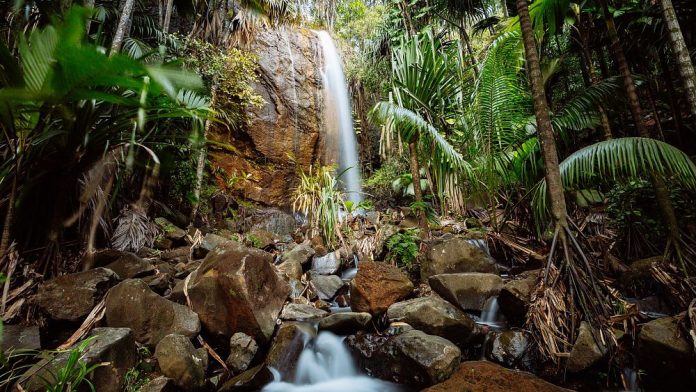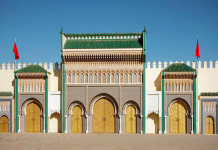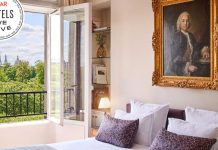The life of a local moves slowly on the sweeping Seychelles sands – really, really slowly. And, it has done for thousands of years.
That’s because being a local means being one of the many thousands of giant tortoises that roam the pearly white beaches, the oldest of which are up to 170 years old.
While tourists flock to the Seychelles for year-round sun and the world’s most beautiful beaches, it’s the natural wonders that truly shine.
Made up of 115 islands peppering the Indian Ocean, the archipelago is a global hotspot for biodiversity, with up to 85 per cent of its animals and 45 per cent of its plant species considered endemic.
The biggest group of tortoises, which are the planet’s longest-living land animals, live on the Aldabra Atoll, which is the birthplace of 190-year-old giant tortoise Jonathan, who is believed to be the oldest known land creature alive today.
A Unesco-protected island, Aldabra is a raised chain of coral that forms one of the Seychelles’ most fragile and untouched ecosystems.
Located more than 1,000km from the capital Mahé, visitors need to get special permission to visit the island, which is inhabited solely by animals.
With no airstrip, harbour, hotel or guesthouses, Aldabra is a logistical challenge to reach, but those who do make the journey will find themselves in one of the most beautiful corners of the globe – with some of its rarest species for company.
As well as being home to around 100,000 tortoises – the largest population in the world – Aldabra is a haven for rare birds, including the magnificent frigatebird, the Aldabra drongo, the white-throated rail and the red-footed booby bird.
Back on solid land, visitors can get up close and personal with the giant banded snail, which was once thought to be extinct or dip their toes in the central lagoon where rare dugongs zip playfully through turquoise waters.
Explore the world’s smallest national park
A riot of green amid a sapphire blue sea, Moyenne Island is but an emerald speck when viewed from the sky.
But go beneath the verdant canopy and you’ll be met with breathtaking biodiversity in one of the last truly unspoilt islands on the planet.
For former British newspaper editor Brendon Grimshaw, the raw beauty and untamed jungle of the abandoned island were so intoxicating that he never left.
After purchasing the land for €9,000 in the 1960s, Grimshaw dedicated his life to conserving it, planting 16,000 trees, forging paths through the undergrowth and attracting 2,000 species of bird to its shores.
In 2009, he set up a perpetual trust to protect the island and signed an agreement with the Seychelles’ Ministry of Environment to include Moyenne as part of Saint-Anne Marine Park, granted with its own special status. With that, Moyenne Island National Park was born.
Today, the island retains its rugged charm under the protection of the Moyenne Island Foundation, though eco-conscious tourists are welcomed in modest numbers to the 400m-long 300m-wide natural sanctuary.
And, apart from a restaurant serving local Creole dishes, a small museum dedicated to Grimshaw’s life and two nurseries for giant tortoise hatchlings, the island remains blissfully undeveloped.
Wander through a pre-historic palm forest
When General Gordon of Khartoum visited the Seychelles island of Praslin in 1881, he returned to London claiming to have discovered the original Garden of Eden.
But rather than sampling apples at the green oasis, coconuts are the forbidden fruit of the day and have been for thousands of years.
Vallée de Mai is a Unesco-listed pre-historic palm forest at the heart of the island, where all six species of palm grow together with the legendary coco de mer wearing the crown.
Here, everything is supersized with the coco de mer reaching up to 30m in height and the voluptuous seeds weighing up to 30kg.
Another breeding ground for giant tortoises, eagle-eyed visitors will also spot tiger chameleons, tree frogs, crimson-crested blue pigeons and the black parrot – which is one of the world’s rarest birds – though a rampaging T-Rex wouldn’t seem out of place.
Off the coast of the islands, the biodiversity continues, with seagrass meadows flourishing beneath the cobalt waters.
These vast underwater ecosystems are excellent at sequestering carbon and form a home for unique marine ecosystems in the process.
Currently, the Seychelles has an estimated 20,000sqkm of seagrass surrounding its coastline, 100 per cent of which it pledged to protect in 2021 – along with its mangroves – as part of its commitments to the Paris Agreement.
The wonders of Mahé Island
Flora and fauna weave their way through the very fabric of life on the Seychelles, permeating every inch of its golden shores.
On Mahé Island, natural rarities fill the Morne Seychellois National Park, which sprawls across 20 per cent of the island’s land area encompassing coastal mangrove forests to mountain peaks.
A hiker’s paradise, signposted trails lead up to the peaks of Trois Frères, Morne Blanc and Copolia, the latter of which is an easy 45 minutes to the 500m-high summit.
On the descent, visitors can take a pit stop to appreciate endangered jellyfish trees, tropical screw pines and carnivorous pitcher plants.
For instant access to nature’s bounty without leaving the main city, The Botanical Gardens are just a ten-minute walk from the capital of Victoria.
One of the most visited conservation sites in the country, the garden is popular with both locals and tourists, with attractions including more coco de mer palms, a huge variety of endemic plant species and Thai and Chinese-themed gardens.
And with flourishing rare plants at every turn and the cries of endemic species filling the air, sustainable travel in the Seychelles isn’t a sacrifice – it’s a privilege.













